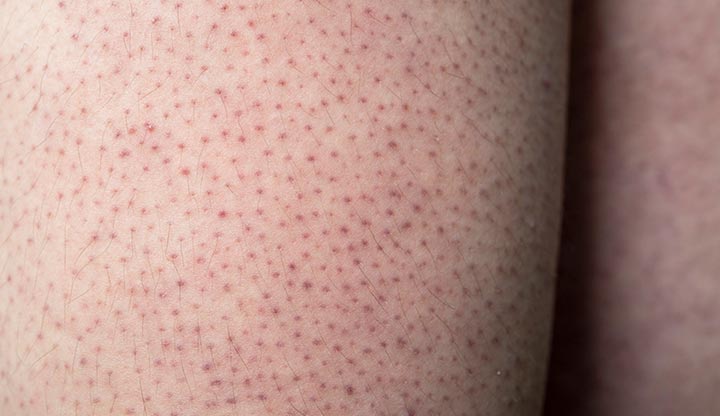Overview Of Keratosis pilaris
Keratosis pilaris (KP), often referred to as "chicken skin," is a common, benign skin condition that leads to the appearance of small, rough bumps on the skin. These bumps are typically flesh-colored, white, or red and most commonly appear on the upper arms, thighs, cheeks, and buttocks. KP is caused by the buildup of keratin, a protein in the skin, within hair follicles.
Symptoms of Keratosis pilaris
- - Small, Rough Bumps: The bumps, which are typically painless, appear on the skin and resemble goosebumps. ([Mayo Clinic](https://www.mayoclinic.org/diseases-conditions/keratosis-pilaris/symptoms-causes/syc-20351149)) - Dry, Rough Skin: Affected skin areas may feel dry and rough to the touch. - Itching or Irritation: Some people experience itching, especially in dry weather.
Causes of Keratosis pilaris
- -
- Keratin Buildup: The primary cause of KP is the accumulation of keratin, a protein that protects the skin, inside the hair follicles, which leads to clogged pores and the formation of bumps. ([Mayo Clinic](https://www.mayoclinic.org/diseases-conditions/keratosis-pilaris/symptoms-causes/syc-20351149)) -
- Genetics: KP often runs in families, suggesting that genetics play a significant role in its development. ([NHS](https://www.nhs.uk/conditions/keratosis-pilaris/)) -
- Other Skin Conditions: Individuals with dry skin conditions, such as eczema, are more likely to develop KP. ([Cleveland Clinic](https://my.clevelandclinic.org/health/diseases/17758-keratosis-pilaris))
Risk Factors of Keratosis pilaris
- - Family History: Having a family member with KP increases the likelihood of developing the condition. ([NHS](https://www.nhs.uk/conditions/keratosis-pilaris/)) - Dry Skin: People with naturally dry skin are at a higher risk for KP. - Other Skin Conditions: Conditions like eczema can increase the risk of developing KP.
Prevention of Keratosis pilaris
- While KP may not be preventable due to its genetic nature, maintaining a skincare routine that includes gentle exfoliation and moisturizing can help manage the condition and improve skin appearance. Avoiding excessive scratching or picking at the bumps can also help reduce the risk of scarring.
Prognosis of Keratosis pilaris
- Keratosis pilaris is a harmless condition that often improves with age. While treatments can reduce the appearance of bumps, they may not completely eliminate them. Consistent treatment can lead to noticeable improvements over time.
Complications of Keratosis pilaris
- - Scarring: While KP is not harmful, persistent scratching or picking at the bumps may lead to scarring. - Skin Discoloration: In some cases, KP can cause skin discoloration, which may persist even after the bumps have resolved.
Related Diseases of Keratosis pilaris
- - Eczema: People with eczema, a condition that causes inflamed, itchy skin, are more likely to develop keratosis pilaris. - Ichthyosis Vulgaris: A genetic disorder that causes dry, scaly skin, which often coexists with keratosis pilaris.
Treatment of Keratosis pilaris
- **Topical Exfoliants**: Creams containing alpha hydroxy acids, salicylic acid, or lactic acid help to exfoliate the skin and prevent the buildup of keratin. ([Mayo Clinic](https://www.mayoclinic.org/diseases-conditions/keratosis-pilaris/diagnosis-treatment/drc-20351152)) - **Moisturizers**: Regular use of moisturizers can soften the skin and help reduce the rough texture caused by KP. - **Prescription Treatments**: In more severe cases, a doctor may prescribe topical retinoids to promote skin cell turnover and reduce keratin buildup.
Generics For Keratosis pilaris
Our administration and support staff all have exceptional people skills and trained to assist you with all medical enquiries.

Adapalene 0.1% Topical
Adapalene 0.1% Topical

Salicylic Acid 10% + Urea 10% Topical
Salicylic Acid 10% + Urea 10% Topical

Salicylic Acid 6% & 12% Topical
Salicylic Acid 6% & 12% Topical

Adapalene 0.1% Topical
Adapalene 0.1% Topical

Salicylic Acid 10% + Urea 10% Topical
Salicylic Acid 10% + Urea 10% Topical

Salicylic Acid 6% & 12% Topical
Salicylic Acid 6% & 12% Topical


